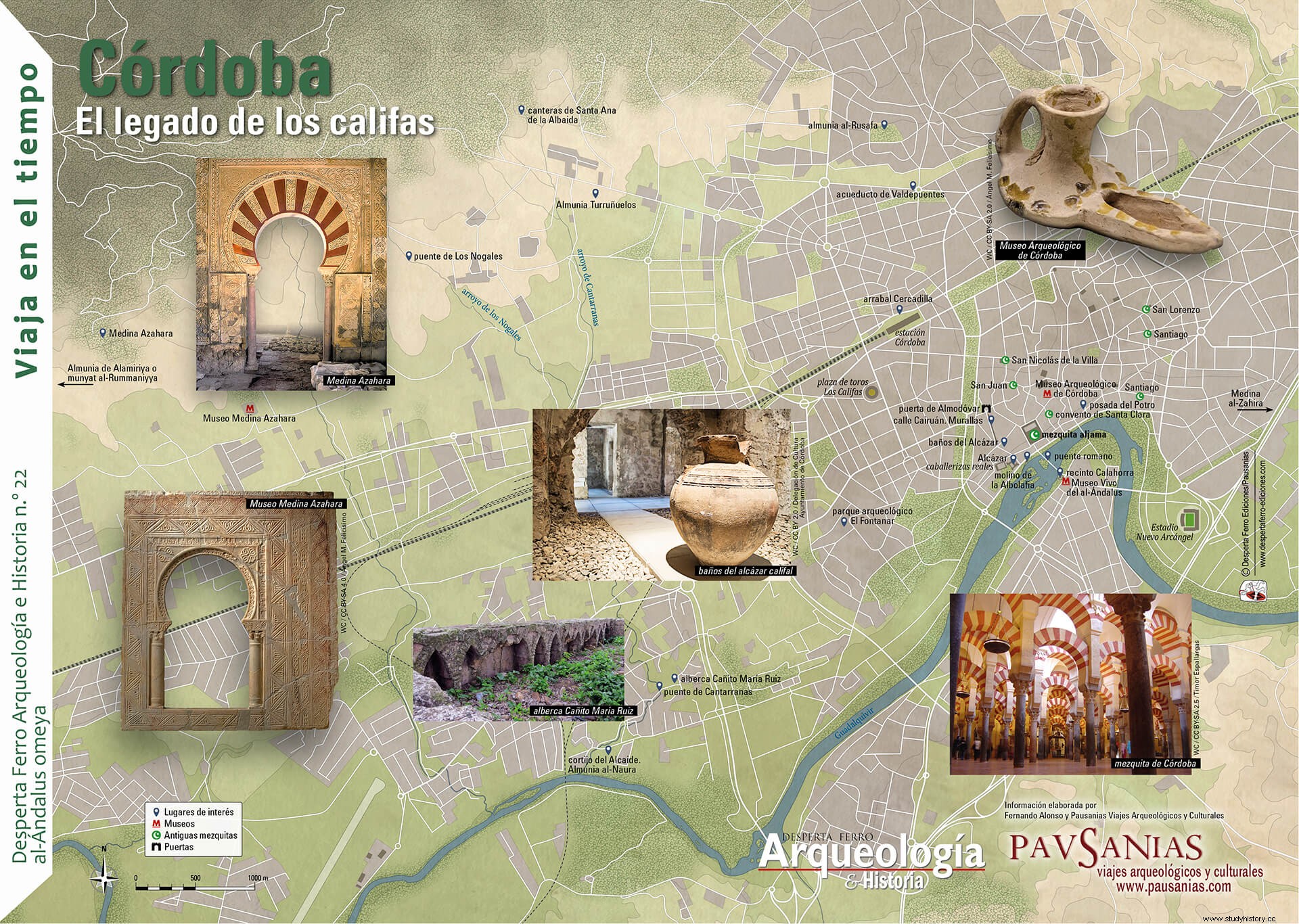
Our archaeological journey to Caliphate Cordoba will begin, with our Archeology and History No. 22:Al-Andalus Umayyad , crossing the walls west of the city along Cairuán street , walls that reuse Roman and Visigoth elements. We will reach the current Almodóvar gate , mostly rebuilt in Christian times (14th century) although over the Islamic one called Bad al-Yawz, the only survivor of the enclosure with nine entrances of 'Abd al-Rahmân I. The Roman bridge to the south on the Guadalquivir it continued to be used and was reinforced during the Umayyad period, controlling its passage through the current Calahorra tower , much rebuilt in Christian times and inside whose interior today you can visit the Al-Andalus Living Museum centered on Córdoba as an example of coexistence of the three cultures:Islamic, Jewish and Christian. Very close to the bridge, on the right bank of the Guadalquivir, the Albolafia mill is preserved. ordered to be built by ‘Abd al-Rahmân II in the 9th century to raise the water from the river to the palace of the emirs through an ingenious aqueduct. Part of the so-called Valdepuentes aqueduct of Roman origin reused in Islamic times can be seen in the small section preserved in the north of the city in the current roundabout of Santa Beatriz and in the bridge that crosses the stream of the same name.
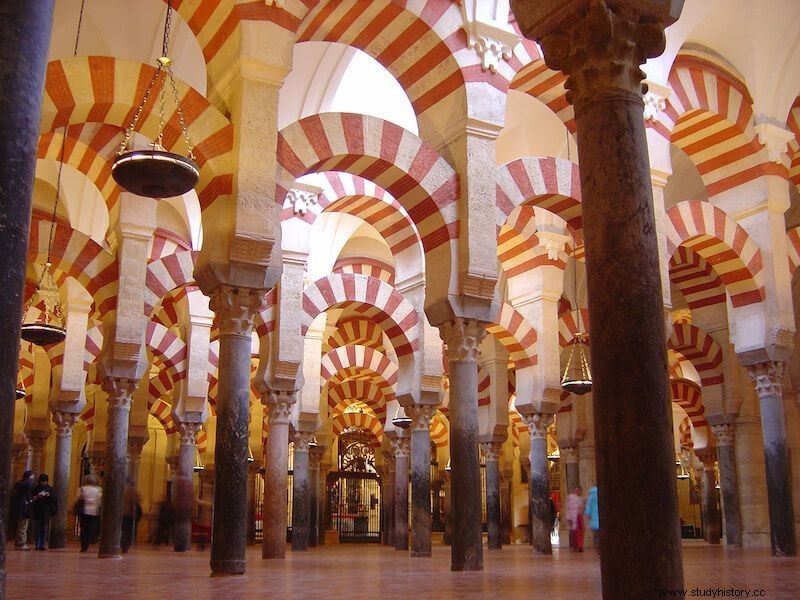
The aljama mosque de Córdoba, an obligatory stop on our archaeological journey to Caliphate Córdoba, summarizes the complete evolution of Umayyad art, as well as overlapping the Christian styles of Gothic, Renaissance and Baroque with the construction inside the building of the current cathedral. It consists of two different areas, the patio or sahn where the minaret stands, inaugurated in 756 by the first caliph 'Abd al-Rahmân III; and the prayer room or haram that rises like a forest of columns with two-tone horseshoe arches on which semicircular arcades are arranged. Successive extensions from the second half of the 8th century to the beginning of the 11th, mainly to the prayer room, gave it its current form. The Umayyad fortress , would encompass a large area that would include the Christian fortress and the episcopal palace, at the base of which you can see the walls and towers of the original palatine building. In the Campo Santo de los Mártires square, the ruins of the caliphate baths were exhumed of the city built by al-Hakam II in the middle of the 10th century. To the south of the alcazar complex was the main gate of Bab al-Sudda, with a roof-viewpoint from where the rulers contemplated on the esplanade up to the river the military parades and public executions. Al-Hakam II built an elevated walkway or sabbat that directly connected the fortress with the aljama mosque, heir to another previous one that was further north.
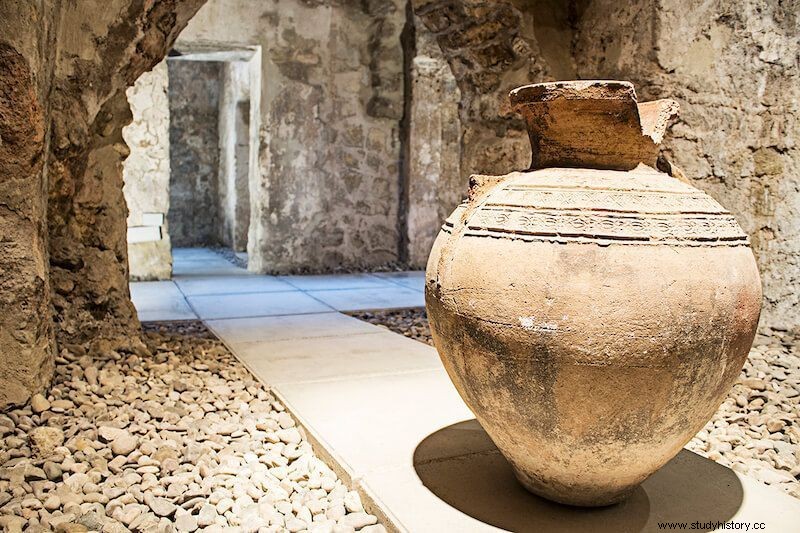
Other bathrooms Arabs that can be visited are the so-called Santa María preserved in part of a current home on Velázquez Bosco street. They were built in the Mudejar era but on a 10th-century lavatory related to the nearby Aljama mosque. You can tour the changing room and the hot and cold rooms, conserving original galleries with horseshoe arches, caliphal capitals and even an elliptical cistern more than ten meters deep. Of the old minor or neighborhood mosques survive under current churches such as San Nicolás de la Villa, San Lorenzo or San Andrés or the most visible in its minaret-tower of the church of San Juan or the convent of Santa Clara , both from the 10th century. Of this same type we have the mosques of the suburbs such as those found under the current churches of San Lorenzo or Santiago , the latter with the oldest dated minaret-tower in the 9th century, still visible.
Before continuing our archaeological journey to Caliphal Cordoba beyond the walls of the medina, we must visit the Archaeological Museum of Cordoba, where we can admire the rich collection of Islamic art on its second floor with architectural remains such as bases and capitals or plasterwork as well as metal objects, mostly bronzes, goldsmiths and a magnificent numismatic collection.
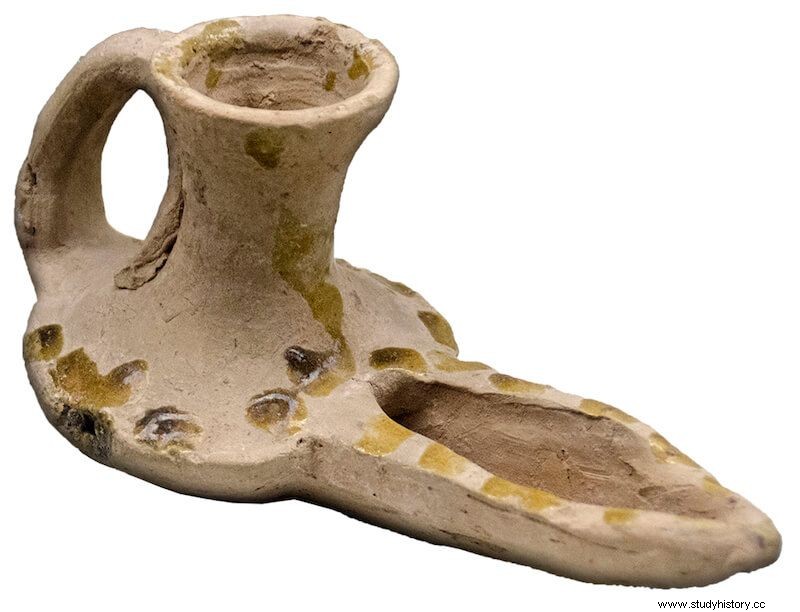
Of the suburbs, it is known that there were up to twenty – to the east that of al-Sarquiyya (today Axerquía), to the west that of al-Garbi (the current Algarve), and to the south that of Saqunda (Field of Truth)–. The surrounding territory was made up of the almunias or farms both in the fertile plain and in the mountains. This is the case of the caliphal neighborhood recovered at the site of Cercadilla or the almunia of al-Rusafa, northeast of the medina, where 'Abd al-Rahmân I first used a similar design from his grandfather Hishâm in Syria. On the right bank of the Guadalquivir was the Almunia de al-Naura in the current Cortijo del Alcaide, of whose remains we can visit the Cañito de María Ruiz pool medium-sized with a row of intersecting brick arches on the south wall and a layer of hydraulic cladding painted with web. Closer to the city to the west is the almunia de El Fontanar , where an archaeological park is planned, with a large residential building from the 9th century with various transformations up to the 11th century in an area of 8,000 m 2 . Associated with the Camino de los Nogales, it was reached from the northwest from Córdoba to the almunia de Turruñuelos , and from there continue to Medina Azahara, the end point of our archaeological journey to the Caliphal Córdoba.
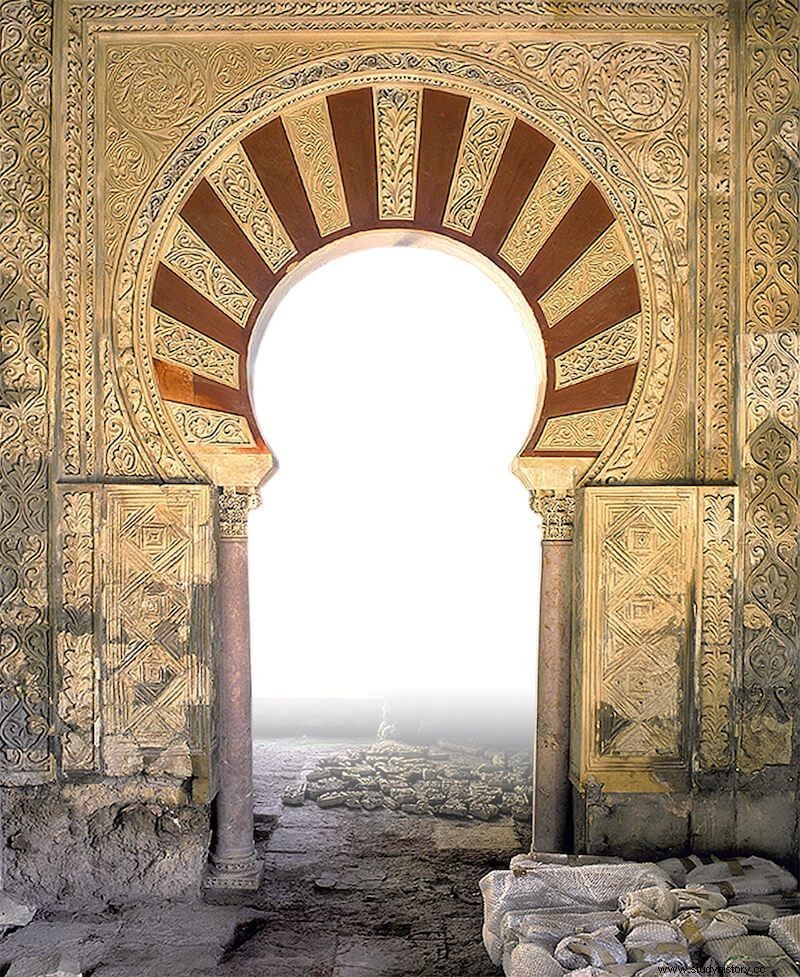
Among the bridges that crossed the streams in the area, the Vallehermoso bridge has disappeared, but the Cantarranas and Los Nogales bridges remain . The first with a barrel vault and the second with three horseshoe vaults. At the foot of the mountain range between Córdoba and Medina Azahara is the Santa Ana de la Albaida quarry with at least six holdings and a long entry and exit chamber for pack animals. In the 10th century we witness the foundation of the new palatine city of Medina Azahara , founded by the caliph 'Abd al-Rahmân III in 936, true capital and seat of Umayyad political power ever since. The entire palatine residence is divided into patios, but the throne room opens onto a scenic garden with pools and canals. You must accompany the visit to the Museum of Medina Azahara , where you can admire a permanent collection with architectural pieces and objects of the highest quality. The complex was marginalized by Almanzor who founded another palatine city called Medina al-Zahira or Azahira (off the map), which some recent proposals place on the right bank of the Guadalquivir. The Las Pilas deposit It is located a few meters to the west and has four cisterns, one with two apses, linked to an almunia. Two kilometers further west, another agricultural enclave or almunia de Alamirilla or al-Rummaniyya has been identified. (off the map) first interpreted from the time of Almanzor and which we know today belonged to Durrir al-Sagir, treasurer of al-Hakam II, and which was given to the caliph along with his belongings in 973. The set is made up of room structures attached to a large pool that served to irrigate the three terraces of the agricultural complex.

